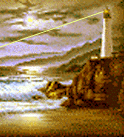

The Fifty Miracle Principles
of A Course in Miracles
by Kenneth Wapnick
Principle 29
Miracles praise God through you.
They praise Him by honoring His creations, affirming their perfection.
They heal because they deny body-identification
and affirm spirit-identification.
One of the Judaeo-Christian ideas is that we should praise God. Certainly a lot of the Psalms have that aspect to them. Clearly, though, God does not need us to praise Him. He does not have an ego that would require people to praise Him (text, p. 64; T-4.VII6:1-3). The way in which a miracle praises God is by simply reflecting His being and His all-inclusive Love, not by words or actions.
One way special love is distinguished from real love is that special love is always an exclusive phenomenon. It always excludes certain people. The Love of God is all-inclusive; He makes no exceptions. As the Bible says, God has no favorites. Miracles praise this Love of God by uniting all people in our mind. "They praise Him by honoring His creations, affirming their perfection." The miracle is a shift from seeing someone as imperfect, whether we see that person as an imperfect body because he or she is physically sick, or we see that person as imperfect because we have judged him or her as being sinful. We then shift from that perception to the Holy Spirit's perception which looks beyond the error to the truth, looks beyond the darkness of the ego to the light of Christ that shines in that person.
"They heal because they deny body-identification and affirm spirit-identification." This idea is the same as that expressed in Principle 17. They heal because they move away from identifying with the body, which is not the problem, by identifying with the spirit. It is the spirit that is the source of the answer. And by identifying with Who we really are, we are recognizing that everything else is merely a defense against this truth.
Q: Can you do that and not recognize where they are mentally or physically? In other words, denying what you are seeing, and wanting to see the perfection of the person.
A: There is a way of looking that the Course sets forth, which is like a double vision. You do not deny what your eyes see; you do not deny someone who is in physical pain or someone who has some need or whatever. But at the same time, you are also realizing that what you are seeing is a call for help. That is what A Course in Miracles calls the judgment of the Holy Spirit (text, p. 200; T-12.1): that the sickness and the pain, or the anger and the attack, whatever it is the person has done, is really a call for help and an expression of that person's identification with his or her ego.
Q: In a specific instance, how far do I take it?
A: You say to the Holy Spirit or to Jesus; or whomever you feel you are talking to: "What would you have me do?" If you find yourself getting upset by the person's problem, whatever the level is, then before you ask Him what you should do, you should ask His help that your perception be healed. That is what is meant by "the only meaningful prayer is for forgiveness" (text, p. 40; T-3.V6:3). You first ask that He help you shift from the ego's way of looking to His way of looking, and then you say, "What would you have me do? What would be the most loving way for me to act at this point?" And then you do it. You first try to be aware of your own interference. Again, whether someone's sickness brings out a lot of pity in you, guilt, pain, or hurt, or whether someone's behavioral characteristics bring out a lot of anger in you -- that is what you pray for help with. And then say, "What would be the most loving thing for me to do? What would you have me do?" Whatever words you want to use are fine, but you certainly do not deny what you see. This is not a course in denial. In fact, the text says, in a passage I read from earlier, that it is almost impossible to deny one's physical experience in this world. It is not suggesting that we do that, because the next line says that this is a particularly unworthy form of denial (text, p. 20; T-2. IV.3:8-11).